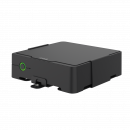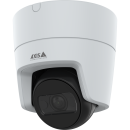
Facing down workplace aggression and complaints in healthcare
CoxHealth combats workplace violence with Axis body worn cameras, de-escalating aggression, and holding public safety and security officers – and the public – to a higher standard of conduct.

Dealing with escalating aggression
From humble beginnings in a Springfield residential duplex over a century ago, CoxHealth has grown into southwest Missouri’s premiere healthcare system. The network extends across 25 counties and includes six hospitals, more than 80 physician clinics, five emergency departments, as well as walk-in clinics and urgent care facilities. In a typical year the CoxHealth system handles more than 1.4 million clinic visits and 260,000 ER, urgent care, and trauma visits. Its Level 1 trauma center in Springfield alone handles over 80,000 patient visits a year.
Like other healthcare facilities across the country, CoxHealth faces workplace violence on a daily basis. “There's always been violence in healthcare, especially patient-generated violence,” says Alan Butler, System Director for Public Safety and Security at CoxHealth. “But over the last couple of years, we’ve seen the level of violence and aggression escalate exponentially.”
Transitioning to the Axis body worn camera system has been a smart move for CoxHealth. The body worn cameras are durable, easy to use for our officers and the video and audio quality has been outstanding. And the support we’ve received from Axis and NetWatch, our integrator, has been outstanding as well.”

Capturing every incident live
In response, CoxHealth decided to equip its public safety and security officers with body worn cameras to help them record incidents, hopefully de-escalate situations, and deal with false claims of officer misconduct. But their first experience with the technology was less than successful. “The equipment was pretty fragile, and the recordings were not good,” says Butler.
The search for a replacement system led the healthcare system to the Axis body worn camera system. “The Axis body worn cameras are a lot more durable and user friendly to operate than our previous system,” states Butler. “It’s just a single button activation.”

Butler also appreciates the simplicity of offloading the recorded video. When an officer comes off shift, they just place the camera in an Axis docking station that automatically offloads the video and sends it to the server. The docking station also recharges the camera so that it’s ready for the next shift of users in a matter of minutes.
To ensure they record every incident fully, CoxHealth set up the body worn cameras with a 30-second pre-buffer. “Most incidents actually start before the officer has an opportunity to push the activation button,” explains Butler. “This feature allows us to back up and see what happened even as the officer was arriving at the scene.”
It was also important that the Axis solution integrate with CoxHealth’s existing Genetec video management platform. “We didn’t want a standalone system,” says Butler. “And NetWatch, our security systems integrator, was able to make the integration virtually seamless.”

Sharing cameras across shifts
To maintain round-the-clock coverage, CoxHealth schedules officers in three 8-hour shifts. Rather than permanently assign a specific camera to each officer, which would leave the camera idle two out of three shifts, CoxHealth turned to NetWatch to come up with a more cost-efficient alternative.
The solution was to add RFID card readers to the system. This allows officers to swipe their fob and have the system controller automatically assign them any of the available cameras in the docking station. It also links the officer’s credentials to the recording for accurate archiving and retrieval. “It was a real team effort between our lead programmer, Axis technical support, and Genetec,” says Matt Haley, NetWatch Senior Account Manager.
“The solution allows us to optimize our camera investment without compromising safety and security,” claims Alan Butler. “To date, we’ve not had a single mismatch between officers and their recordings.”

Revealing missing details
Butler says CoxHealth often uses the recordings to counter bogus complaints against its officers. He likens the cameras to a third-person witness who’s beyond reproach. Sometimes the cameras reveal more about a situation than initially realized.
Butler told of an assault case at the Springfield hospital. When the video was viewed frame-by-frame it led CoxHealth to level a more serious charge against the perpetrator. “We thought it was a simple case of an individual throwing a punch at an officer,” reports Butler. “But when we watched the recording frame by frame, we could clearly see that the individual had inserted a key between his fingers and was attempting to use it as a weapon.”
A natural complement to surveillance cameras
Axis body worn cameras have added another layer of security to CoxHealth, augmenting the hundreds of Axis cameras already deployed throughout its hospitals and clinics. “CoxHealth has been standardizing on the Axis portfolio for more than a decade, gradually replacing older analog cameras and video encoders, with the latest Axis camera technologies,” explains NetWatch’s Matt Haley.
For instance, by strategically deploying AXIS P37 Series multi-sensor cameras, CoxHealth achieves greater exterior coverage with fewer cameras and licensing fees. AXIS Q-line PTZ (pan/tilt/zoom) cameras help security capture the license plates of vehicles entering and leaving the campus. And AXIS M31 Series with their wide fields of view keep close watch over critical locations such as waiting areas and hallways with automated medication dispensing cabinets.

Providing essential tools to do the job
CoxHealth is discovering that like their traditionally deployed Axis cameras, their new body worn cameras from Axis are providing value on multiple levels.
“Our officers are very possessive of their cameras,” says Butler. “They see them as necessary protection against wrongful claims, but also as tools to help them de-escalate confrontations.”
Officers often review their recordings when preparing their incident reports to accurately note timelines and sequences of events. Moreover, supervisors and officers use the recordings for training and self-evaluation.
“The training value of the video is priceless,” states Butler. “Once they’ve stepped back from the actual event, the learning value is very high. Most times the officer self-identifies what they did wrong, and they’ll tell you what they would’ve done differently if they had to do it over again. And that’s the kind of professional growth that keeps everyone safe.”
“When we put this system in place, we got the support we needed – not only from NetWatch, but Axis and Genetec as well,” shares Butler. “I feel we got it right this time because we’ve all worked really well together as a team.”

Body worn cameras help mitigate workforce violence
CoxHealth deploys new body worn camera solution to increase patient, visitor, and staff safety. The Axis Communications solution offers crucial functionality and user friendly features for the Missouri healthcare system.
Products & solutions

Healthcare

AXIS Q6315-LE PTZ Network Camera
High-end outdoor-ready HDTV 1080p PTZ camera with quick-zoom and laser focus
Learn more
